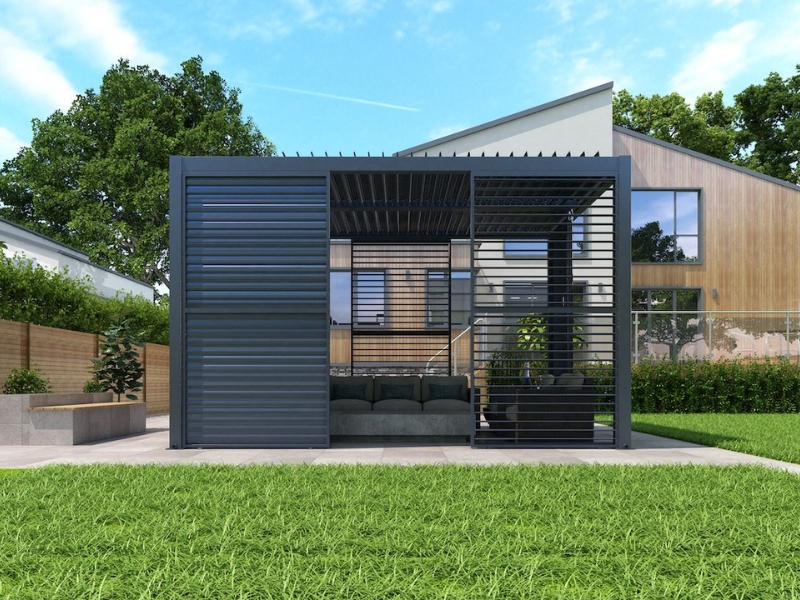When installing a pergola, one of the most important considerations is the depth of the footings. The footing depth plays a crucial role in ensuring the structure’s stability and longevity. Understanding the right depth for your pergola footings will help prevent shifting, cracking, or damage from weather conditions. This article will explore why the depth of pergola footings is vital, the factors that influence this depth, and how to get it right for a sturdy and safe outdoor feature.
Why is the depth of pergola footings important for stability?
The depth of your pergola’s footings impacts how well the structure withstands external forces like wind, rain, and even the weight of the pergola itself. A well-designed footing ensures that the pergola remains anchored, providing stability and reducing the risk of it shifting or collapsing over time. Here’s why footing depth matters:
- Weight distribution: Proper footing depth helps distribute the weight of the pergola evenly across the ground.
- Prevention of shifting: Shallow footings can cause the pergola to shift, leading to structural issues.
- Long-term durability: Deeper footings offer better resistance to natural forces, prolonging the pergola’s life.
- Compliance with local regulations: In some areas, building codes dictate minimum footing depths for safety and stability.
What factors influence the depth of pergola footings?
The depth of pergola footings isn’t a one-size-fits-all measurement. Several factors come into play when determining the right depth for your footings:
- Pergola size and weight: Larger, heavier pergolas require deeper footings to support their weight.
- Soil type: Different soils, such as sandy or clay-based, affect how deeply footings need to be embedded.
- Climate conditions: Areas with extreme weather may require deeper footing for stability.
- Local building codes: Certain regions have specific requirements for footing depth to ensure safety and durability.
In addition to structural considerations, understanding the benefits of shade structures can help you create a more comfortable and protected outdoor environment. Pergolas not only provide style but also offer an ideal solution for adding shade to your outdoor space.
What are the recommended depths for pergola footings?
While the required depth for pergola footings can vary, general guidelines can help you get started. Here are some recommended depths based on different conditions:
- Standard pergola: For most standard pergolas in stable soil, a depth of 600mm to 800mm is generally sufficient.
- Larger pergolas: Larger or heavier structures may require footings that go as deep as 1 metre or more.
- Weak or loose soils: Softer or sandy soils may need deeper footings, possibly exceeding 1 metre, to provide adequate support.
Remember, these depths are general guidelines, and it’s essential to adjust based on your specific location and soil conditions. If you’re wondering how to build a pergola, understanding the essential steps and materials is key to a successful project.
What materials are suitable for pergola footings?
Choosing the right materials for your pergola footings is crucial for ensuring strength and durability. Here are some of the most common materials used:

- Concrete: Concrete is the most widely used material for pergola footings. It’s strong, durable, and can withstand outdoor conditions.
- Concrete with rebar: For added strength, many people use rebar to reinforce the concrete footing, particularly for larger or heavier pergolas.
- Post anchors: Metal post anchors provide a secure way to anchor pergola posts to concrete footings, ensuring they remain stable over time.
- Gravel: In some cases, gravel is used to help drainage around the footing, reducing the risk of water pooling and causing damage.
Each of these materials has its benefits, depending on the pergola size, design, and location.
How do soil conditions affect pergola footing depth?
Soil conditions play a major role in determining how deep the footings for your pergola need to be. Here’s how different soil types can affect footing depth:
- Clay soils: Clay can expand and contract with moisture changes. Deeper footings may be required to ensure stability.
- Sandy soils: Sandy soil is less stable, so deeper and more reinforced footings may be necessary to prevent shifting.
- Rocky soils: In rocky areas, you may not need very deep footings, but you’ll need to take care when digging to avoid large rocks.
- Loamy soils: Loam is typically stable, so standard depths are usually sufficient for footings in this type of soil.
Always have your soil tested if you’re unsure about its composition. Knowing your soil conditions will help you select the correct depth for your footings.
Can you adjust the footing depth for different pergola designs?
Yes, the depth of the footings can vary depending on the design and size of your pergola. For example:
- Louvered pergolas: You can enjoy the perfect outdoor space with a louvered roof pergola, offering flexibility and comfort throughout the year. A motorised or manual louvered pergola may require deeper footings due to the additional weight of the louver system.
- Wall-Mounted pergolas: While these may have less direct load on the footings, the depth still needs to be sufficient for the structure’s weight and stability.
- Freestanding pergolas: This requires deeper footings than wall-mounted designs because the posts bear all the weight of the structure.
What tools and materials do you need for pergola footing installation?
Installing pergola footings requires a few basic tools and materials. Here’s a list of what you’ll need:
- Shovel or post-hole digger: To dig the holes to the required depth.
- Concrete: For creating a solid footing base.
- Rebar (optional): For reinforcement, especially in larger or heavier pergolas.
- Level: To ensure the footing is level and correctly aligned.
- Post anchors: If you’re using metal post anchors to secure the pergola posts.
Should you hire a professional for pergola installation?
While DIY pergola kits make the installation process much easier, some homeowners prefer to hire a professional to handle the installation, particularly when it comes to footing installation. Here are some things to consider:

- Expertise: A professional installer has the experience to ensure that the footings are at the correct depth and properly installed.
- Time and effort: If you’re short on time or unsure about your DIY skills, hiring a professional can save you stress.
- Complex designs: Larger or more complex pergola designs may require professional installation for optimal stability and safety.
However, if you’re confident in your DIY abilities, you can easily handle the footing installation for your pergola by building your own pergola with easy-to-follow kits.
Create your perfect outdoor space with Unique Pergolas!
At Unique Pergolas, we offer a range of DIY Pergola Kits designed to make the installation process easy and rewarding. Our kits include all the materials you need, along with clear instructions, so you can create the perfect outdoor space for your home or business. For those who prefer a professional touch, we also offer installation services to ensure your pergola stands strong for years to come.
Contact Unique Pergolas for expert advice and enhance your backyard or outdoor living space today!


